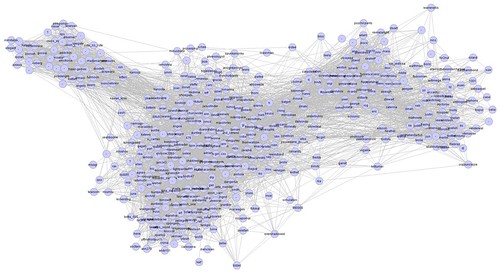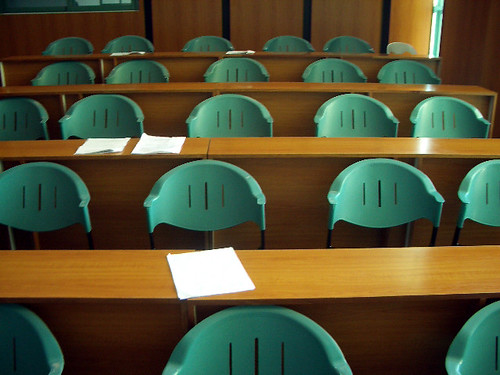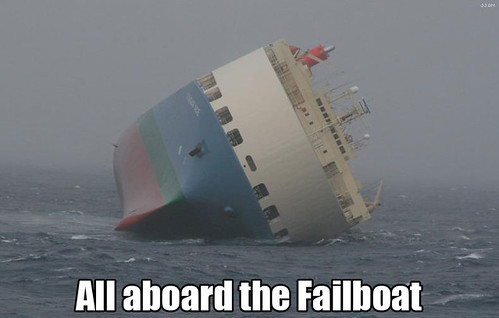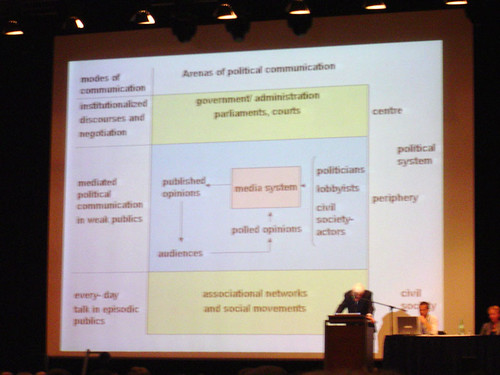Photo courtesy of -nathan via Flickr and Creative Commons
Some anecdotal observations from "watching" Obama's address to the nation this evening.
I'm not new to a multimedia, multi-platformed, swithtasking approach to watching major moments in political television. I gathered friends over for nearly every last debate (back when no one really knew a lot about Mike Gravel other than the fact that he had one of the oddest and most humorous online videos in presidential candidate history) and dealt with the span of their reactions to my insistance that I have a laptop in front of me and a Twitter feed ticking by.
Back then, barely a year ago, I found it difficult to keep up. I would be reading a Tweet, trying to listen to a friend's comment, and pay attention to what the candidates were actually saying all at the same time. Maybe it was just being a late adopter, but it was hard to keep up.
Tonight however it was like second nature. I saw a post come up in my Twitter aggregator (TwitterFox -- which throws it into a manageable add-on for my Firefox browser) with a simple tag: #NSOTU. It took me less than a full second to realize that was the tag for tonight's speech (read: Not State of the Union). Before President Obama was even a few minutes into the speech, someone posted a link to the full text of his speech. So in addition to listening to the commentary of the people in the room, reading the Tweets, paying attention to the visual images on my television and listening to Obama speak, I was reading along.
It was hard to keep up, with about 50 new posts per minute requesting my browser to refresh itself. A lot of the comments made it feel like I was sitting in a much larger living room with a bigger group of friends. In other words, a lot of commentary was focused on how fast Pelosi rose to her feet or placing bets on when we would finally hear the phrase "clean coal."
But occaisionally there was a spark of deliberation. And though it seemed a mere speck in a large mine of banality, someone would inevitably catch it and react. So small pockets of conversation were flittering around and I saw as voyeour -- all the while keeping to myself but reading along.
Tuesday, February 24, 2009
Changing landscapes

Image of FlickrLand (Flickr's social network) from GustavoG via Flickr and Creative Commons
Though Wahl-Jorgensen's book is rather dry and academic, I honestly find the content fascinating. And thanks to my many years in academia, I appreciate the endlessly annotated nature of the writing, even if its coming in my least favorite to read format of parenthetical notations. However any attempt to discuss any aspect of the journalism industry seems somehow dramatically outdated when compared to the reality of the current newspaper crisis. With reports as high as 15,000+ jobs lost for journalists in 2008, the landscape for journalism has been so dramatically impacted that it can be difficult to stay focused on an assessment that doesn't take these changes into account.
Lately I've been agreeing with thinking about journalism in a new frame. With so much information at our fingertips, it is possible that the role of the journalist is changing from information provider to discussion facilitator. Wahl-Jorgensen's placement of letters to the editor next to other forms of "mediated participation" falls short in today's world of Twitter and viral social networks. The idea of radio call-in programs or television talk shows as an advanced state of participation seems distant.
But the real difference is not simply how many more ways there are to participate, it is in how we define participation. Ultimately it is important to keep one distinction in mind: those old formats relied on a gatekeeper to control access to the audience. With platforms on the Internet everyone gets a shot, everyone gets a microphone, and everyone can get an audience. Moderated comments on a newspaper article or website may control some of the conversation, but for each location it is restricted in it can move to dozens of other un-mediated locations.
Labels:
commenting,
many-to-many,
twitter,
Wahl-Jorgensen
Letter to the editor -- Part Two

I wrote my second LTE for The Boston Globe after noticing a piece discussing the merits of being a child of affluent parents if applying to private college -- especially during the economic recession.
This letter has a similar theme from the last one, but with an altered framework. Unlike the last letter I sent to the Hampshire Gazette, the article that prompted the Globe letter was influenced by the comments of readers that trailed after the post.
Reading through some of the drivel made me favor the commenting method of sites like Slashdot, which allow the community to rate the best ones up and push the poor ones down.
Anyway, here it is:
The American Dream sure is seeing a revision. Instead of opening her arms to the tired and the poor, she'll just be sure to check your credit rating before opening the gate.
Peter Schworm's piece in Tuesday's Globe (“Economy lifting college prospects of the well heeled”) makes one thing certain – if students from affluent families are more likely to be admitted into private schools than those requiring financial aid, we can be assured that our public schools will see an even greater increase in applications in the coming years as they are turned away from these institutions.
Investment in public higher education is vital during difficult economic times. State community colleges and four year schools are in dire straights. By the end of last year, dramatic increases in applications at state schools (see Boston Globe “Applications soar at public colleges,” Dec. 23, 2008) were already present. We have a choice: we can prioritize education for the next generation of American workers or we can leave education only to the wealthy.
Labels:
class,
higher education,
letters to the editor
Monday, February 23, 2009
Letter to the editor -- Part One
 Photo courtesy of bill dwyer via Flickr and Creative Commons
Photo courtesy of bill dwyer via Flickr and Creative CommonsI sent this in to the Daily Hampshire Gazette this evening in response to an article in Monday's paper regarding a 129% increase in applications at Holyoke Community College. I suppose now we will just wait and see...
As an alumnae of Holyoke Community College who is about to graduate from Smith College in May, I am heartened by the increase in applications reported by Kristin Palpini in Monday's Gazette (“HCC hit by wave of college hopefuls”). I enrolled at HCC merely because it was affordable, but was inspired with the quality of education I received. Programs such as the Learning Communities, which pair off traditionally separated academic disciplines (such as math and literature), presented challenging coursework. All were taught by a dedicated faculty who are tirelessly committed to the mission of education despite being under constant threat of budgetary cutbacks.
The American Recovery and Reinvestment Act reflects President Obama's campaign promises to both invest in education and long-term economic growth. According to the Public Higher Education Network of Massachusetts (PHENOM) this includes a possible $813 million for education funding in this state. At least $142 million of this will be allocated to public higher education. PHENOM also sees potential for piloting free tuition at three of the state's community colleges through federal budgetary relief for Medicaid.
The 129% increase in applications at HCC is a tremendous opportunity. Education is one of our best investments in difficult economic times. I hope our legislators work with the strong network of Massachusetts residents and organizations to ensure that every single person who wants to enroll in college is able to access the quality education our state schools must provide.
Labels:
commenting,
higher education,
letters to the editor
Wednesday, February 18, 2009
Old formats spewing old stereotypes; remain closed for comments
 Photo courtesy of Certified via Flickr and Creative Commons
Photo courtesy of Certified via Flickr and Creative CommonsToday’s edition of the media-mogul Rupert Murdoch owned New York Post featured a cartoon that has drawn extensive (and I would say deserved) criticism from the blogosphere for its portrayal of a monkey shot dead by police officers with the caption "They'll have to find someone else to write the stimulus bill." The cartoon has also been severely criticized by civil right leaders, such as the Rev. Al Sharpton.
The New York Post is standing behind the cartoon and its artist, Sean Delonas, claiming that it is was meant to imply that the stimulus bill recently signed into law by President Obama was shoddily composed and may has well have been written by a monkey. It also attempts to parody a violent pet chimpanzee that was shot dead by police officers in Stamford, CT on Monday. However, America's culture of slavery and certainly its connection to racist sentiments is not as far behind us as Post Editor-in-Chief Col Allan may believe.
Allan has issued a statement claiming that, ""The cartoon is a clear parody of a current news event, to wit the shooting of a violent chimpanzee in Connecticut. It broadly mocks Washington's efforts to revive the economy." Allan continues this verbal march of ignorance by stating that "again, Al Sharpton reveals himself as nothing more than a publicity opportunist."
Though it is possible that the artist's intentions were as Allan states and lacked a malicious intent, it remains a poor reflection on Delonas and Allan's poor education in American cultural history. This tactic of turning a blind eye towards a very recent past in which African Americans were compared to primates, presumed to lack the same intellectual abilities as whites, and were bought and sold as property seems at best an ignorant oversigh and at worse an outright racist act.
The Post cartoon itself and the Associated Press coverage remain closed for comment. Instead, users on news aggregation sites like Digg are reposting the story and commenting on these sites. A write-up on The Huffington Post reveals some 4078 comments on the story.
Tuesday, February 17, 2009
"Happy V-day, Nice Pants" (or, Commenting IRL)
 Photo courtesy of Greg Saulmon at MassLive.com
Photo courtesy of Greg Saulmon at MassLive.com In the ongoing experiment of active online commenting, I finally posted my first comment to a piece on MassLive today.
I don't know if it is entirely fair, considering my previous disclosures about enjoying the safety of social networks, as I know the author of the post. Still, I pressed send and watched the words vanish behind the wall of the moderator. Something tells me that it will be our very own guest lecturer from last week who either passes it on or hits "delete."
However this post does double-duty, as I not only took the great leap forward of adding my opinion to the pile (that would be a pile of one, as there was not a lot of traffic surrounding it), but the piece I chose to comment on had to do with commenting IRL! (That's acronym-online speak for in real life for any readers who have not spent the last four years of their life consumed by academic treatises on the Internet).
Greg's post is titled, "Things people say when you give them a space to say them." The photo captures a message that is both witty and entertaining as well as timely commentary on our culture.
He writes about these interactions with public sphere from his own experience as an online journalist:
...When you give people the space to say what they want, you're going to get a fascinating mix of incredibly smart and incredibly stupid comments.So, today in Northampton, when I spotted a collection of paper hearts with hand-written messages taped to the kiosk outside Urban Outfitters, I felt the same little twinge of excitement that I feel when I see a news story followed by a long comment thread. What are people saying? What are people thinking?
In the case of the paper hearts, the messages were mostly predictable: ruminations on love; commemorations of anniversaries.
There among them, though, was the message above -- a paper heart talking to a chain store. In a sense, from Anonymous, to Anonymous. Is it an example of the impersonality of commerce, or an example of how there are more ways than ever to say what you're thinking?Honestly, I'd say it is a little bit of both...
Labels:
commenting,
culture,
feedback journalism,
IRL commenting,
northampton mass,
pop
Jorgensen: selected highlights
 "Arenas of political communication" - slide in Jürgen Habermas's keynote at ICA 2006 in Dresden -- Courtesy of Snibe via Creative Commons license
"Arenas of political communication" - slide in Jürgen Habermas's keynote at ICA 2006 in Dresden -- Courtesy of Snibe via Creative Commons licenseWhat should be the role of the public and the press? Is democracy better served when journalists and experts communicate the information to the public or when the public can actively participate in the deliberative process? And how do the market mechanisms of the commercial newspaper industry impact these debates?
Karin Wahl-Jorgensen has tackled these questions through a solid network of critique, primarily using the theories of Habermas to compare and contrast various models. She provides a useful framework on the public sphere, while also bringing in legitimate critique from a range of disciplines. But of particular interest to me (the ever-curious cultural and media critic) were her takes on public journalism and exploration of liberal and deliberative democratic theory (particularly as it relates to the press).
Jorgenson glosses over a concept of of public journalism which is interesting, albeit rather abstract and academic. She provides no real background on what it is or any existing models. I'm not sure if she is talking about what is often referred to as “citizen journalism” (a problematic term in and of itself) of if this is another term for some branch of publicly funded media.
With regards to liberal vs. deliberative democratic theory, I found the debate surrounding rational vs. irrational debate fascinating. Though I value and uphold a belief in the necessity of a free (and funded) press to facilitate a democratic society, I think chasing after a distinction between rational and irrational is a red herring. True rationality is a myth, just like objectivity.
Finally, the format of deliberation is shifting away from a reliance on print and experts/gatekeepers. Some seem more willing to experiment with these new possibilities than others...
Tuesday, February 10, 2009
Bill Keller and the future of news(papers)
 (Photo courtesy of Just.Luc via Creative Commons/Flickr)
(Photo courtesy of Just.Luc via Creative Commons/Flickr)New York Times executive editor, Bill Keller, made a lengthy "column" out of responding to readers comments and questions on their website last week. The first series of questions delved into some of the big issues facing journalism today -- including what will happen to newspapers in the near future with so much media consumption moving online.
I can see two threads that must be identified here when discussing the "newspaper crisis." One deals with the user's choice of format. Dramatic shifts in media consumption from the printed to the web page can be identified, but they are only part of the story. People still consume traditional (print, broadcast) media at a rapid pace and the websites visited for news online are predominantly the same established brands. And with millions of people in America living without access to affordable high-speed Internet, these trends shouldn't come as too big a surprise.
The second is paying for content and journalists. Commercial media is starting to collapse under the weight of its behemoth holdings. The rampant consolidation that escalated dramatically in the mid 1990s -- allowing companies to continue buying more outlets across mediums and in the same markets -- have bared the brunt of such cost-cutting measures as slashing reporters' jobs in order to maintain the bottom line. It is far cheaper to produce weather, sports, or entertainment pieces than it is to pay journalists to do investigative reporting. The foreign bureaus began to close. Reporters were asked to fill the roles of news anchors instead of writers.
It is possible that the commercial model can't continue to service the public need for reporting in this country. But this could signal tremendous opportunity. The ideas and concepts can be seen throughout the myriad of proposals popping up across the field itself. From establishing a National Endowment for Journalism, to micro-payments for content by the user, to the television tax model used by the BBC across the pond, the discussion about driving a wedge between the co-dependent relationship of advertising and reporting is getting louder.
And if all else fails, we could always go for the flavored ink model.
Labels:
digital vs analog,
journalism,
newspapers,
print
Monday, February 9, 2009
Fair Use, Fairey, and Closed Comments

It's not that I don't have feedback. I have a lot of it. But I tend to localize it into quasi-personal Internet spaces, like the falsified “safe walls” of Facebook, updating my Gmail chat status, or Twitter. So there is an element of experimentation in this whole “commenting on commenting” initiative we've got going on. I planned to take the plunge directly and instead of providing my feedback through the spurious safety net of this blog I would boldly post my opinion on directly to the article or piece that struck a chord with me in the first place.
Turns out that is easier said than done.
A friend of mine sent along this article last week about the Associated Press going after graphic artists Shepard Fairey for copyright infringement. As a staunch supporter of our desperate national need for intellectual property policy reforms, I figured this would be a timely and interesting issue to provide feedback on. But as I scanned the responses on the Huffington Post I realized that perhaps it would be more interesting to post my comments in a space where there was less online community consensus around the issue. When someone forwarded the same story to me, but this time NPR's coverage I figured I had struck the gold mine: many of the comments on the article sided with the AP and agreed that Fairey had indeed perpetrated copyright infringement. (Actually, the comments ran the gambit from well phrased positions to complete intellectual failures, but that's another matter all together).
The moral of the story is that the comments were closed. Because I had not responded to the piece in a timely manner (which is how long exactly?) no additional comments were being permitted on the article.
We can envision “commenting” as some sort of evolution of the “letters to the editor” format, but there are some failures in this conception. Unlike the printed newspapers that are typically discarded by the time the next issue is released, journalism online meanders and lingers and travels in unpredictable trajectories. Closing off comments with attention to the timing of the story may be putting up a roadblock to creativity. Just like suing artists for copyright infringement over works that should be covered by fair use does.
Thursday, February 5, 2009
This is so meta
Photo from fish2000, courtesy of Creative Commons/Flickr
Hello world.
Im using this blog to comment about commenting. As I said, this is so meta.
Consider this the meta of meta. I'm just commenting on the fact that I will be commenting on commenting.
Put the microphone in front of the amplifier and crank it.
With feedback as the objective...well...yeah.
Hello world.
Im using this blog to comment about commenting. As I said, this is so meta.
Consider this the meta of meta. I'm just commenting on the fact that I will be commenting on commenting.
Put the microphone in front of the amplifier and crank it.
With feedback as the objective...well...yeah.
Subscribe to:
Comments (Atom)


